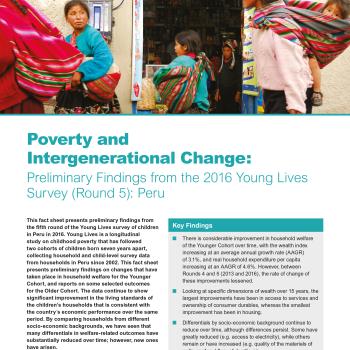
Round 5 Longitudinal Poverty and Intergenerational Change Fact Sheet
This fact sheet presents preliminary findings from the fifth round of the Young Lives survey of children in Peru in 2016. Young Lives is a longitudinal study on childhood poverty that has followed two cohorts of children born seven years apart, collecting household and child-level survey data from households in Peru since 2002. This fact sheet presents preliminary findings on changes that have taken place in household welfare for the Younger Cohort, and reports on some selected outcomes for the Older Cohort. The data continue to show significant improvement in the living standards of the children’s households that is consistent with the country ́s economic performance over the same period. By comparing households from different socio-economic backgrounds, we have seen that many differentials in welfare-related outcomes have substantially reduced over time; however, new ones have arisen.
Key Findings:
There is considerable improvement in household welfare of the Younger Cohort over time, with the wealth index increasing at an average annual growth rate (AAGR) of 3.1%, and real household expenditure per capita increasing at an AAGR of 4.6%. However, between Rounds 4 and 5 (2013 and 2016), the rate of change of these improvements lessened. Looking at specific dimensions of wealth over 15 years, the largest improvements have been in access to services and ownership of consumer durables, whereas the smallest improvement has been in housing. Differentials by socio-economic background continue to reduce over time, although differences persist. Some have greatly reduced (e.g. access to electricity), while others remain or have increased (e.g. quality of the materials of walls, roof and floor of dwellings). At the age of 22, the Older Cohort is substantially better off in terms of educational attainment and adult height compared to their parents. Socio-economic differences are of a different nature, depending less on school completion and more on higher education.
Round 5 Longitudinal Poverty and Intergenerational Change Fact Sheet
This fact sheet presents preliminary findings from the fifth round of the Young Lives survey of children in Peru in 2016. Young Lives is a longitudinal study on childhood poverty that has followed two cohorts of children born seven years apart, collecting household and child-level survey data from households in Peru since 2002. This fact sheet presents preliminary findings on changes that have taken place in household welfare for the Younger Cohort, and reports on some selected outcomes for the Older Cohort. The data continue to show significant improvement in the living standards of the children’s households that is consistent with the country ́s economic performance over the same period. By comparing households from different socio-economic backgrounds, we have seen that many differentials in welfare-related outcomes have substantially reduced over time; however, new ones have arisen.
Key Findings:
There is considerable improvement in household welfare of the Younger Cohort over time, with the wealth index increasing at an average annual growth rate (AAGR) of 3.1%, and real household expenditure per capita increasing at an AAGR of 4.6%. However, between Rounds 4 and 5 (2013 and 2016), the rate of change of these improvements lessened. Looking at specific dimensions of wealth over 15 years, the largest improvements have been in access to services and ownership of consumer durables, whereas the smallest improvement has been in housing. Differentials by socio-economic background continue to reduce over time, although differences persist. Some have greatly reduced (e.g. access to electricity), while others remain or have increased (e.g. quality of the materials of walls, roof and floor of dwellings). At the age of 22, the Older Cohort is substantially better off in terms of educational attainment and adult height compared to their parents. Socio-economic differences are of a different nature, depending less on school completion and more on higher education.
